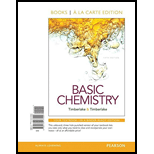
Concept explainers
(a)
Interpretation:
To classify the given fatty acid as saturated, monounsaturated or polyunsaturated.
Lauric acid
Concept Introduction:
A fatty acid is a type of acid which consists of a long unbranched chain of carbon atoms typically 12 to 20 carbon atoms with a carboxylic group at one end of the carbon chain. This long carbon chain is known to make fatty acids insoluble in water. They are mainly of three types. First is the saturated fatty acid which contains only single bonds between the carbon atoms in the chain. Second is the monounsaturated fatty acid which consists of one double bond in its carbon chain, and third are the polyunsaturated fatty acids which contain two or more carbon atoms in their carbon chain
(b)
Interpretation:
To classify the given fatty acid as saturated, monounsaturated or polyunsaturated.
Linolenic acid
Concept Introduction:
A fatty acid is a type of acid which consists of a long unbranched chain of carbon atoms typically 12 to 20 carbon atoms with a carboxylic group at one end of the carbon chain. This long carbon chain is known to make fatty acids insoluble in water. They are mainly of three types. First is the saturated fatty acid which contains only single bonds between the carbon atoms in the chain. Second is the monounsaturated fatty acid which consists of one double bond in its carbon chain, and third are the polyunsaturated fatty acids which contain two or more carbon atoms in their carbon chain.
(c)
Interpretation:
To classify the given fatty acid as saturated, monounsaturated or polyunsaturated.
Stearic acid
Concept Introduction:
A fatty acid is a type of acid which consists of a long unbranched chain of carbon atoms typically 12 to 20 carbon atoms with a carboxylic group at one end of the carbon chain. This long carbon chain is known to make fatty acids insoluble in water. They are mainly of three types. First is the saturated fatty acid which contains only single bonds between the carbon atoms in the chain. Second is the monounsaturated fatty acid which consists of one double bond in its carbon chain, and third are the polyunsaturated fatty acids which contain two or more carbon atoms in their carbon chain.
Want to see the full answer?
Check out a sample textbook solution
Chapter 18 Solutions
Basic Chemistry, Books a la Carte Edition (5th Edition)
 ChemistryChemistryISBN:9781305957404Author:Steven S. Zumdahl, Susan A. Zumdahl, Donald J. DeCostePublisher:Cengage Learning
ChemistryChemistryISBN:9781305957404Author:Steven S. Zumdahl, Susan A. Zumdahl, Donald J. DeCostePublisher:Cengage Learning ChemistryChemistryISBN:9781259911156Author:Raymond Chang Dr., Jason Overby ProfessorPublisher:McGraw-Hill Education
ChemistryChemistryISBN:9781259911156Author:Raymond Chang Dr., Jason Overby ProfessorPublisher:McGraw-Hill Education Principles of Instrumental AnalysisChemistryISBN:9781305577213Author:Douglas A. Skoog, F. James Holler, Stanley R. CrouchPublisher:Cengage Learning
Principles of Instrumental AnalysisChemistryISBN:9781305577213Author:Douglas A. Skoog, F. James Holler, Stanley R. CrouchPublisher:Cengage Learning Organic ChemistryChemistryISBN:9780078021558Author:Janice Gorzynski Smith Dr.Publisher:McGraw-Hill Education
Organic ChemistryChemistryISBN:9780078021558Author:Janice Gorzynski Smith Dr.Publisher:McGraw-Hill Education Chemistry: Principles and ReactionsChemistryISBN:9781305079373Author:William L. Masterton, Cecile N. HurleyPublisher:Cengage Learning
Chemistry: Principles and ReactionsChemistryISBN:9781305079373Author:William L. Masterton, Cecile N. HurleyPublisher:Cengage Learning Elementary Principles of Chemical Processes, Bind...ChemistryISBN:9781118431221Author:Richard M. Felder, Ronald W. Rousseau, Lisa G. BullardPublisher:WILEY
Elementary Principles of Chemical Processes, Bind...ChemistryISBN:9781118431221Author:Richard M. Felder, Ronald W. Rousseau, Lisa G. BullardPublisher:WILEY





